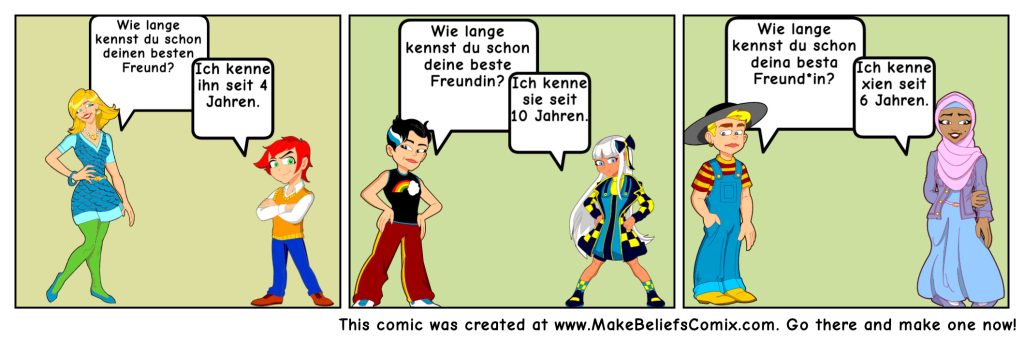4.2 Mehr zu den Freunden

Hallo alle zusammen!
Zum Aufwärmen machen wir unseren Tagesminiplausch und eine Wiederholung.
Wiederholung
In the previous lesson, you learned how to say how long you have known your best friend and to ask others the same question. Let’s review what you have learned.

Wie lange kennst du schon deinen besten Freund? Answer the question in your written journal.
Lektionsüberblick
When you talk about your best friend (or any friendship), you may want to talk about their personality or their physical appearance, perhaps in contrast to yourself. In this lesson, we will work on making statements about your friend. In future lessons, you will learn how to make comparisons. In the end, you will be able to 1) name some of your best friend’s personality traits and 2) name some of your best friend’s physical characteristics.
1) Wie ist dein bester Freund/ deine beste Freundin?
How would you describe your best friend? More specifically, how would you describe their personality? Read along as Yasmin and Max tell you about their best friends. Complete the activity along with the reading.
For more vocabulary to use to describe friends, you can visit these earlier lessons:
3.2 Eigenschaften und Gegensätze
Jetzt bist du dran!
Frankfurt am Main im Blickpunkt

Die Europäische Zentralbank (EZB) steht in Frankfurt am Main im Stadtteil Ostend. Sie hat zwei hohe Türme, den Nordturm mit 185m und den Südturm mit 165m. In der EZB arbeiten ungefähr 2.300 Menschen. Die Deutsche Bundesbank, die nationale Zentralbank von Deutschland, hat ebenfalls ihren Sitz in Frankfurt. Beide Banken sind wichtig für die Stabilität des europäischen Geldsystems.
The European Central Bank (ECB) is located in the east end district of Frankfurt am Main. It has two tall towers, the North Tower and the South Tower, which together are 201 meters high. Approximately 2,300 people work at the ECB. The Deutsche Bundesbank, Germany’s national central bank, is also headquartered in Frankfurt. Both banks are important for the stability of the European monetary system.
2) Wie sieht er/sie/xier aus?
Now let’s look at how Yasmin and Max describe their best friends physical appearance. Read along with the texts a second time and complete the activity.
For more vocabulary to describe friends, you can visit these earlier lessons:
3.8 Körperbeschreibung: Augen und Haare
Jetzt bist du dran!
Zum Schluß

*As you conclude this lesson, don’t forget to check Canvas!*

Media Attributions
- Yasmin and Max images and texts adapted from Grenzenlos Deutsch, licensed under a CC BY-NC-SA 4.0 International License.
Media Attributions
- 1010-1020 banner long large reduced
- 4.1 3 kennen seit make-beliefs-comix © This comic strip was generated at http://www.MakeBeliefsComix.com. Used by permission of author and site creator Bill Zimmerman.
- Photo of “Europäische Zentralbank (EZB)” by Kiefer, CC BY-SA 2.0
- Private: confidence scale_large horizontal_updated

